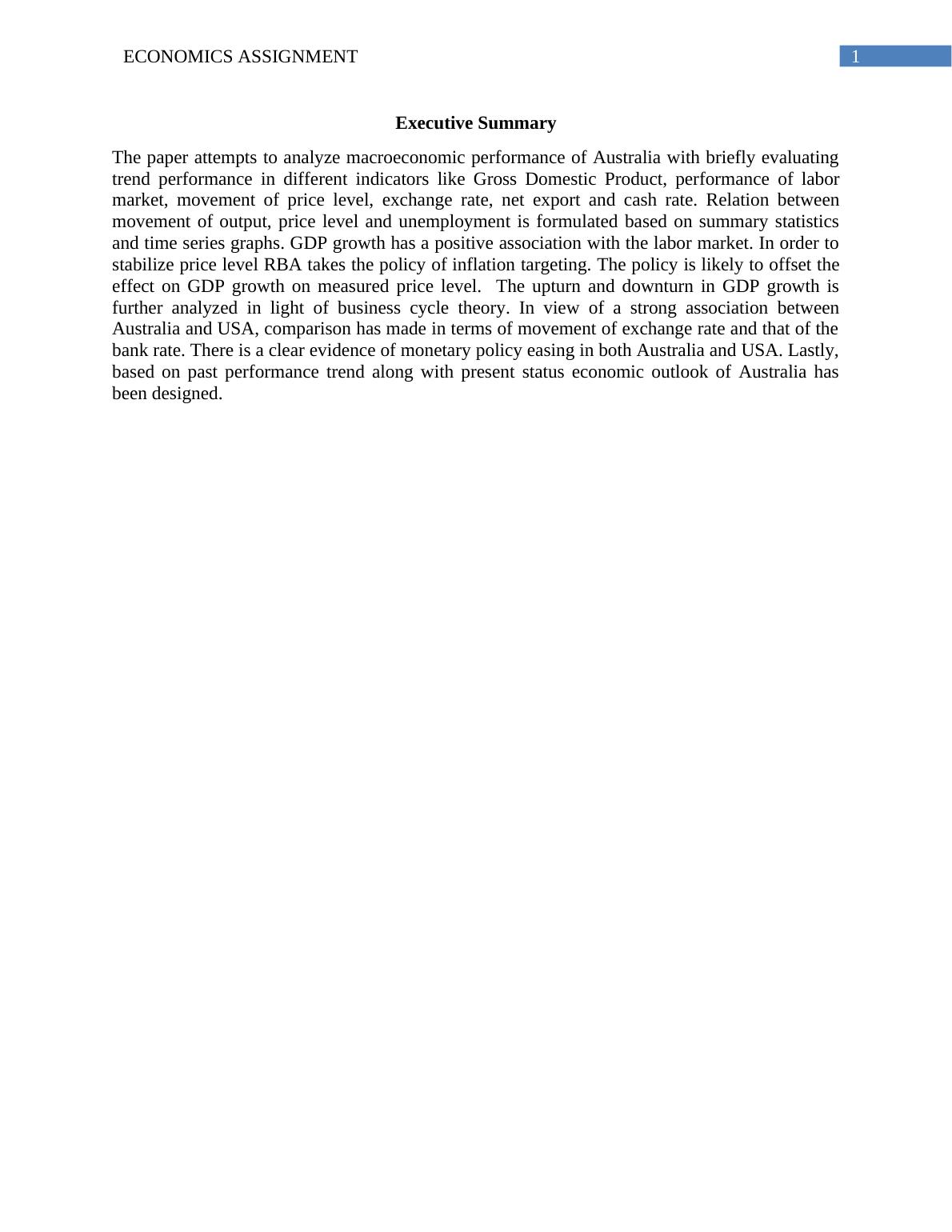Economics Development - Solved Assignment
14 Pages3546 Words38 Views
Added on 2021-05-31
Economics Development - Solved Assignment
Added on 2021-05-31
ShareRelated Documents
Running Head: ECONOMICS ASSIGNMENTEconomics AssignmentName of the StudentName of the UniversityAuthor note

ECONOMICS ASSIGNMENT1Executive Summary The paper attempts to analyze macroeconomic performance of Australia with briefly evaluatingtrend performance in different indicators like Gross Domestic Product, performance of labormarket, movement of price level, exchange rate, net export and cash rate. Relation betweenmovement of output, price level and unemployment is formulated based on summary statisticsand time series graphs. GDP growth has a positive association with the labor market. In order tostabilize price level RBA takes the policy of inflation targeting. The policy is likely to offset theeffect on GDP growth on measured price level. The upturn and downturn in GDP growth isfurther analyzed in light of business cycle theory. In view of a strong association betweenAustralia and USA, comparison has made in terms of movement of exchange rate and that of thebank rate. There is a clear evidence of monetary policy easing in both Australia and USA. Lastly,based on past performance trend along with present status economic outlook of Australia hasbeen designed.

ECONOMICS ASSIGNMENT2Table of ContentsIntroduction......................................................................................................................................3GDP growth, inflation and unemployment......................................................................................3Inflation and GDP growth...........................................................................................................4Unemployment and GDP growth................................................................................................4Evaluation of economic growth with Business Cycle theory..........................................................5Influence of real exchange rate on net export..................................................................................6Cash rate and Fund rate...................................................................................................................8Australian economic outlook.........................................................................................................10Conclusion.....................................................................................................................................11Reference list.................................................................................................................................12

ECONOMICS ASSIGNMENT3Introduction Aggregate performance of an economy depends on the performance of differentindicators at macro level. Aggregate output is measured with gross domestic product. A moreprecise measure of output is real GDP which represents values of all the marketed goods andservices in domination of a fixed base year price (Johnson, 2017). Economic growth measuredwith a growth of GDP brings prosperity for economy and influences other indicators as well.Australia through its rapid progress within a relatively small period of time has made its ownseparate position in the world economy. Mining industry supported by huge stock of naturalresources provides a great support to the Australian economy (Fenna, 2015). Resembling mostother developed nation, Australia is largely a service oriented economy. Trade is an importantcontributor of Australian GDP. The international demand of a commodity depends on rate ofexchange between the nation and therefore, exchange rate is one important attribute of tradebalance. Fund rate as determined by Federal Reserve influences cash rate decision of RBA.Through analysis of macroeconomic performance of past year, the report aims to provide aninsight about future performance. GDP growth, inflation and unemploymentTable 1: Summary Statistics for real GDP growth, inflation and unemploymentSummary Statistics Real GDP growth rate InflationUnemployment Mean3.10Mean2.68Mean6.73Standard Error0.23Standard Error0.28Standard Error0.36Median3.53Median2.49Median6.10Mode#N/AMode#N/AMode6.90Standard Deviation1.21Standard Deviation1.46Standard Deviation1.89Sample Variance1.46Sample Variance2.14Sample Variance3.58Kurtosis1.74Kurtosis2.47Kurtosis-0.18Skewness-1.21Skewness1.15Skewness0.88Range5.38Range7.02Range6.70Minimum-0.38Minimum0.25Minimum4.20Maximum5.01Maximum7.27Maximum10.90Sum83.62Sum72.33Sum181.60Count27Count27Count27The average growth rate in the last 27 years (1990-2016) is 3.10 with an average inflation of 2.68percent and that of average unemployment rate is 6.73. Both the highest and lowest growth rateis achieved in the decade of 1990s. The lowest documented growth rate is -0.38 percent whilethe highest growth rate in 5.01 occurred in the respective years of 1991 and 1999. The highestinflation rate is 7.27 prevailed in 1990. The lowest inflation rate is also recorded in 1990s. Thelowest rate of inflation of 0.25 percent was achieved in 1997 (Eggoh and Khan, 2014). Theeconomy faced maximum problem of unemployment during 1993 with unemployment reached

End of preview
Want to access all the pages? Upload your documents or become a member.
Related Documents
Online Library for Study Material | Deskliblg...
|13
|3848
|329
Evaluation of the Macroeconomic Performance of Australia and USAlg...
|25
|4066
|453
Macroeconomic Performance of Australia from 1990 to 2016lg...
|13
|3611
|62
Macroeconomic Performance of Australia and USAlg...
|23
|3682
|114
Macroeconomic Performance of Australialg...
|13
|3860
|298
Macroeconomics Performance of Australialg...
|14
|4190
|34
